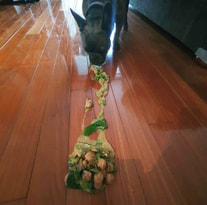
Vet expenses can be very high, especially if any type of operation or specialist care is involved. Ensure that your pet is covered in the event of any unexpected, and unforeseen accidents, any operations, or perhaps diseases or conditions that may develop, and of course to look after your Golden Oldie, when those days arrive. We have 5 simple plans for comprehensive pet insurance coverage. Visit our website at https://genricpet.co.za/
Vomiting - How To Make A Dog Vomit Safely And Quickly
www.yourvetonline.com - a really great website with a 24 hour vet to supply emergency guidance - a good iidea to put contact info on your phone for emergencies. Plus, tons of articles on dogs, cats, horses, little critters and so much more - enjoy
www.yourvetonline.com - a really great website with a 24 hour vet to supply emergency guidance - a good iidea to put contact info on your phone for emergencies. Plus, tons of articles on dogs, cats, horses, little critters and so much more - enjoy
HOT TIP: Add this article to your phone’s home screen for handy access in case of an emergency.
 Pic - Vet on Line
Pic - Vet on Line
Many dogs are notorious for scavenging and it’s not uncommon to discover that your dog has eaten something they shouldn’t have.
For this reason, knowing when and how to make a dog vomit is one of the most important emergency first aid skills you can acquire as a dog owner.
For many toxic substances, timing is critical, as signs of poisoning can occur within 30minutes of ingesting the poison.
When the situation is appropriate, making your dog vomit immediately can help speed up the decontamination process and in many situations, it will prevent severe ill health.
In this article, we describe exactly how to make a dog vomit at home without the need to rush to a vet.
When Is It Not Ok To Make Dogs Vomit?
Before we get started, we must cover when you should NEVER make your dog vomit unless of course, you’ve spoken with a vet who gives you the go-ahead.
Not all situations are safe to induce vomiting in a dog.
There are some situations that when vomiting is induced it can exacerbate the effect of the poison or increase the risk of further complications resulting in your dog becoming critically ill.
For that reason always check with a veterinarian prior to making a dog throw up so that you can be sure you are not only giving the correct antidote but are not going to cause more harm.
In general terms, never make a dog vomit if:
Your Dog Is Already Showing Signs Of Poisoning
If your dog is already showing signs of poisoning then it is too late to induce vomiting and you must get them to a veterinary clinic immediately.
Common signs of poisoning that mean it’s too late to induce vomiting include:
Never induce vomiting in symptomatic dogs
Never Induce Vomiting If Your Dog Has Consumed A Caustic Substance
The second time we never make a dog throw up is when your dog has consumed a caustic or corrosive substance.
There are many hazardous household chemicals that contain highly caustic liquids (strong alkali or acidic substances). Common examples include household cleaners such as bleach, dishwasher and drain cleaners as well as batteries.
These cleaners often contain caustic chemicals such as sodium hydroxide and sulfuric acid that when consumed, burn all tissues that they touch – from the lips to the throat, oesophagus into the stomach and intestines.
These caustic substances cause severe tissue burns when ingested, so it’s not surprising that they’ll burn on the way up (when the dog vomits) so you must NEVER make a dog vomit if they’ve consumed a caustic substance.
Medical Conditions And Conformation Abnormalities
The third time we never induce vomiting is when your dog has a medical condition or a conformation abnormality that could put them at risk of aspiration pneumonia (vomit is inhaled into the airway and lungs rather than swallowed into the stomach).
Acquired conditions that can be problematic when inducing vomiting include megaoesophagus and laryngeal paralysis.
Likewise, congenital conditions such as the shortened skull shape of brachycephalic breeds (squishy nose breeds) like an English or French bulldog, a boxer, pug or Shih Tzu also make them high-risk candidates when inducing vomiting at home.
Dogs that suffer from these conditions are always at a higher risk of aspirating vomit into their lungs due to a malfunctioning swallowing apparatus.
For dogs with these congenital conditions or medical abnormalities, it is far safer to make them throw up under veterinary care where if things don’t go as planned your dog is in a place where they can receive immediate treatment.
For this reason, knowing when and how to make a dog vomit is one of the most important emergency first aid skills you can acquire as a dog owner.
For many toxic substances, timing is critical, as signs of poisoning can occur within 30minutes of ingesting the poison.
When the situation is appropriate, making your dog vomit immediately can help speed up the decontamination process and in many situations, it will prevent severe ill health.
In this article, we describe exactly how to make a dog vomit at home without the need to rush to a vet.
When Is It Not Ok To Make Dogs Vomit?
Before we get started, we must cover when you should NEVER make your dog vomit unless of course, you’ve spoken with a vet who gives you the go-ahead.
Not all situations are safe to induce vomiting in a dog.
There are some situations that when vomiting is induced it can exacerbate the effect of the poison or increase the risk of further complications resulting in your dog becoming critically ill.
For that reason always check with a veterinarian prior to making a dog throw up so that you can be sure you are not only giving the correct antidote but are not going to cause more harm.
In general terms, never make a dog vomit if:
Your Dog Is Already Showing Signs Of Poisoning
If your dog is already showing signs of poisoning then it is too late to induce vomiting and you must get them to a veterinary clinic immediately.
Common signs of poisoning that mean it’s too late to induce vomiting include:
- extreme agitation/hyperexcitement often combined with vocalisation,
- elevated heart rate,
- inability to swallow,
- trouble breathing,
- tremors,
- seizures
- paralysis or unsteady/wobbly on feet,
- vomiting
- coma (passed out)
Never induce vomiting in symptomatic dogs
Never Induce Vomiting If Your Dog Has Consumed A Caustic Substance
The second time we never make a dog throw up is when your dog has consumed a caustic or corrosive substance.
There are many hazardous household chemicals that contain highly caustic liquids (strong alkali or acidic substances). Common examples include household cleaners such as bleach, dishwasher and drain cleaners as well as batteries.
These cleaners often contain caustic chemicals such as sodium hydroxide and sulfuric acid that when consumed, burn all tissues that they touch – from the lips to the throat, oesophagus into the stomach and intestines.
These caustic substances cause severe tissue burns when ingested, so it’s not surprising that they’ll burn on the way up (when the dog vomits) so you must NEVER make a dog vomit if they’ve consumed a caustic substance.
Medical Conditions And Conformation Abnormalities
The third time we never induce vomiting is when your dog has a medical condition or a conformation abnormality that could put them at risk of aspiration pneumonia (vomit is inhaled into the airway and lungs rather than swallowed into the stomach).
Acquired conditions that can be problematic when inducing vomiting include megaoesophagus and laryngeal paralysis.
Likewise, congenital conditions such as the shortened skull shape of brachycephalic breeds (squishy nose breeds) like an English or French bulldog, a boxer, pug or Shih Tzu also make them high-risk candidates when inducing vomiting at home.
Dogs that suffer from these conditions are always at a higher risk of aspirating vomit into their lungs due to a malfunctioning swallowing apparatus.
For dogs with these congenital conditions or medical abnormalities, it is far safer to make them throw up under veterinary care where if things don’t go as planned your dog is in a place where they can receive immediate treatment.
|
|
When To Make A Dog Vomit?
The most common reason to make a dog vomit is when they have ingested something poisonous. Common poisons that we induce vomiting as part of the decontamination process include:
|
However, there may be times when a dog or puppy has eaten a foreign object such as a toy, sock or rock and vomiting may be required.
Please note that when foreign objects are involved – always contact a vet first for advice, as again, inducing vomiting in some circumstances is not advised due to the risk of damage on the way out.
It’s also important to remember that the poison is in the dose.
Just because your dog has ingested something classified as poisonous, does not always mean that they will be poisoned. If in doubt, contact our vets who will be able to advise on the risk.
Never Use These Substances To Induce Vomiting
The internet is a source of many home remedies to make a dog throw up, sadly some of these are quite dangerous and should be avoided at all costs.
1. Salt is frequently recommended to induce vomiting in dogs by uneducated laypeople, however, using it is fraught with danger and can lead to death.
**Remember that salt or sodium poisoning can also occur with the consumption of homemade playdough.
Signs of salt poisoning in dogs include:
It is marginally safer if the rock form is used due to it’s larger surface area.
Avoid at all costs the powdered/tablet form as this is known to cause nasty side effects such as mouth and tongue ulceration and sloughing, oesophagitis and laryngeal oedema and ulceration resulting in perforation and in some cases, death.
We cannot recommend its use.
3. Bicarbonate soda (bicarb, baking soda) in water or mustard in water are other remedies you may see mentioned in articles.
These substances don’t cause harm, but also will rarely make your dog heave, so are pointless.
Steps To Make A Dog Throw Up
Before you start, always contact a veterinarian for guidance.
If you have seen your dog eat a poisonous substance the safest and most effective method to induce vomiting is to use Hydrogen Peroxide 3%. Higher concentrations are far too irritating to the gastrointestinal tract.
It’s always handy to have a bottle of hydrogen peroxide 3% in your pet’s first aid kit, however, be warned that it tends to expire relatively quickly, especially once it’s been opened.
For that reason, always check that the hydrogen peroxide still works before you give it to your dog!
You can do this by pouring a little down the sink and you should see and hear it bubbling. If there is no bubbling, then it has lost its potency and will not work.
Hydrogen Peroxide 3% Dose Rate
Give 10ml of hydrogen peroxide 3% per 10kg of your dog’s weight (that’s equivalent to 2 teaspoons per 25 pounds).
Never give more than 60-80mls (small dog, large dog) total as too much can cause other clinical problems due to its irritant nature.
How To Administer Hydrogen Peroxide
The easiest way to give hydrogen peroxide is via a syringe or turkey baster.
Remember DO NOT GIVE MORE THAN 60-80mls of hydrogen peroxide in TOTAL.
What To Do After My Dog Vomits
It’s important to remember that the process of inducing vomiting is only the first step in the decontamination process.
It doesn’t necessarily mean that your dog won’t require further treatment and care.
For many toxins, your dog will still require assessment and or treatment at a veterinary clinic.
After your dog has vomited, it is best to check your dog’s vomit to see if it contains evidence of the poison eg. the blue/green pellets of slug bait, or raisins.
To find out whether it is best to seek further assessment at a clinic, contact our veterinary team (available online 24/7) with information about the poison ingested.
We can then advise what the best course of action is so that your dog doesn’t suffer any ill effects.
What Information Should I Provide My Vet?
When you contact a vet, be prepared to provide the following important information about your dog and the poison:
Be Careful Making A Puppy Vomit
A puppy will always be more sensitive to poisons as well as any antidote that causes vomiting.
Purposely making a puppy throw up can sometimes make the situation worse.
If in doubt, it’s always wise to speak to a vet before pursuing any DIY dog vomiting method especially when a puppy is involved.
Can I Use Hydrogen Peroxide To Make My Cat Vomit?
Sadly, for cats, there is no safe at-home remedy to induce vomiting.
Hydrogen peroxide is far too irritating and if given can cause severe mouth, oesophagus and stomach burns.
If you see your cat consume a poisonous substance then you must take them to the vet immediately.
Please note that when foreign objects are involved – always contact a vet first for advice, as again, inducing vomiting in some circumstances is not advised due to the risk of damage on the way out.
It’s also important to remember that the poison is in the dose.
Just because your dog has ingested something classified as poisonous, does not always mean that they will be poisoned. If in doubt, contact our vets who will be able to advise on the risk.
Never Use These Substances To Induce Vomiting
The internet is a source of many home remedies to make a dog throw up, sadly some of these are quite dangerous and should be avoided at all costs.
1. Salt is frequently recommended to induce vomiting in dogs by uneducated laypeople, however, using it is fraught with danger and can lead to death.
**Remember that salt or sodium poisoning can also occur with the consumption of homemade playdough.
Signs of salt poisoning in dogs include:
- vomiting,
- diarrhoea,
- incoordination – wobbly and unsteady gait,
- tremors,
- seizures,
- coma,
- death
It is marginally safer if the rock form is used due to it’s larger surface area.
Avoid at all costs the powdered/tablet form as this is known to cause nasty side effects such as mouth and tongue ulceration and sloughing, oesophagitis and laryngeal oedema and ulceration resulting in perforation and in some cases, death.
We cannot recommend its use.
3. Bicarbonate soda (bicarb, baking soda) in water or mustard in water are other remedies you may see mentioned in articles.
These substances don’t cause harm, but also will rarely make your dog heave, so are pointless.
Steps To Make A Dog Throw Up
Before you start, always contact a veterinarian for guidance.
If you have seen your dog eat a poisonous substance the safest and most effective method to induce vomiting is to use Hydrogen Peroxide 3%. Higher concentrations are far too irritating to the gastrointestinal tract.
It’s always handy to have a bottle of hydrogen peroxide 3% in your pet’s first aid kit, however, be warned that it tends to expire relatively quickly, especially once it’s been opened.
For that reason, always check that the hydrogen peroxide still works before you give it to your dog!
You can do this by pouring a little down the sink and you should see and hear it bubbling. If there is no bubbling, then it has lost its potency and will not work.
Hydrogen Peroxide 3% Dose Rate
Give 10ml of hydrogen peroxide 3% per 10kg of your dog’s weight (that’s equivalent to 2 teaspoons per 25 pounds).
Never give more than 60-80mls (small dog, large dog) total as too much can cause other clinical problems due to its irritant nature.
How To Administer Hydrogen Peroxide
The easiest way to give hydrogen peroxide is via a syringe or turkey baster.
- Draw up the advised volume into your syringe or baster.
- Back your dog into a corner of the room to assist you to keep them still.
- While standing with your back to the wall and over your dog (facing the same direction), gently lift their lips near the corner of their mouth and insert the nozzle of the syringe and express the dose. Don’t stress if some dribbles out. You will see your dog swallowing and the peroxide may start foaming in the mouth. That is absolutely fine and what we want to see.
- Within 5 to 10 minutes your dog will likely be looking nauseous and may start salivating (dribbling) excessively.
- Most dogs will vomit within 15minutes.
- If no vomit occurs after this time period, repeat the process with the same dose.
- Most dogs will vomit a couple of times and stop after approximately 45 minutes. If they continue to vomit, you will need to seek veterinary care.
- Make sure that your dog cannot access the vomit and re-ingest it.
- Collect the vomit and examine it for evidence of the toxin. (Bag it so that your vet can also analyse it).
- Go to the vet clinic for further treatment as recommended by the vet you initially spoke with.
Remember DO NOT GIVE MORE THAN 60-80mls of hydrogen peroxide in TOTAL.
What To Do After My Dog Vomits
It’s important to remember that the process of inducing vomiting is only the first step in the decontamination process.
It doesn’t necessarily mean that your dog won’t require further treatment and care.
For many toxins, your dog will still require assessment and or treatment at a veterinary clinic.
After your dog has vomited, it is best to check your dog’s vomit to see if it contains evidence of the poison eg. the blue/green pellets of slug bait, or raisins.
To find out whether it is best to seek further assessment at a clinic, contact our veterinary team (available online 24/7) with information about the poison ingested.
We can then advise what the best course of action is so that your dog doesn’t suffer any ill effects.
What Information Should I Provide My Vet?
When you contact a vet, be prepared to provide the following important information about your dog and the poison:
- what poison did they eat – it’s always wise to take the product with you and/or take photos of the label including the ingredients,
- an estimate of how much was consumed,
- the time that your dog consumed the poison ie. 30 minutes ago vs 12 hours ago,
- your dog’s weight,
- any existing health conditions including any medications that they are currently receiving.
Be Careful Making A Puppy Vomit
A puppy will always be more sensitive to poisons as well as any antidote that causes vomiting.
Purposely making a puppy throw up can sometimes make the situation worse.
If in doubt, it’s always wise to speak to a vet before pursuing any DIY dog vomiting method especially when a puppy is involved.
Can I Use Hydrogen Peroxide To Make My Cat Vomit?
Sadly, for cats, there is no safe at-home remedy to induce vomiting.
Hydrogen peroxide is far too irritating and if given can cause severe mouth, oesophagus and stomach burns.
If you see your cat consume a poisonous substance then you must take them to the vet immediately.




